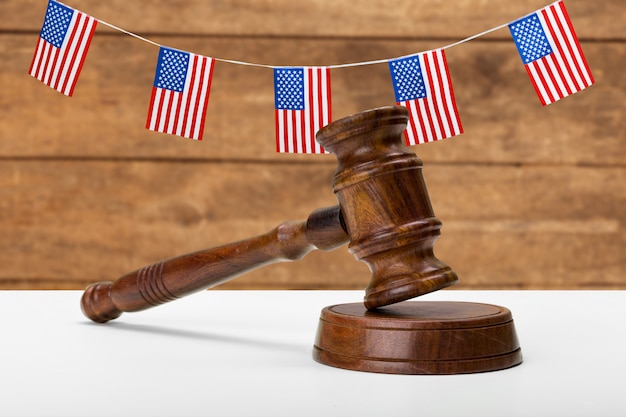Supreme Court to Review Affirmative Action: Key Implications

The Supreme Court is set to hear cases challenging affirmative action policies in college admissions, potentially reshaping how race is considered in higher education decisions.
The **Breaking: Supreme Court to Hear Case on Affirmative Action Policies in College Admissions – What’s at Stake?**, with significant ripples expected across the landscape of higher education and equal opportunity in the United States.
Affirmative Action Under Scrutiny: The Supreme Court’s Role
The Supreme Court’s decision to hear arguments on affirmative action has once again brought the contentious issue to the forefront of national debate. This section explores the court’s historical involvement with affirmative action and sets the stage for understanding the upcoming case.
Affirmative action, in its essence, refers to policies and programs designed to address historical and ongoing discrimination against marginalized groups, particularly in education and employment. These policies aim to create a more level playing field by considering factors such as race, ethnicity, and gender in admissions and hiring decisions.
A Brief History of Affirmative Action Cases
The Supreme Court has a long history of grappling with the constitutionality of affirmative action. Landmark cases such as *Regents of the University of California v. Bakke* (1978) and *Grutter v. Bollinger* (2003) have shaped the legal landscape, establishing certain limits and guidelines for affirmative action policies. The court has generally held that while race cannot be the sole determining factor in admissions, it can be considered as one factor among many to achieve a diverse student body.
- Regents of the University of California v. Bakke (1978): Ruled against strict racial quotas but allowed race to be considered as one factor in admissions.
- Grutter v. Bollinger (2003): Upheld the University of Michigan Law School’s affirmative action policy, emphasizing the importance of diversity in higher education.
- Gratz v. Bollinger (2003): Struck down the University of Michigan’s undergraduate admissions policy, which awarded points based on race.
Understanding the history of these cases is crucial for appreciating the complexity of the legal arguments surrounding affirmative action. The Supreme Court’s upcoming decision will likely build upon this precedent while also potentially introducing new interpretations of the Equal Protection Clause of the Fourteenth Amendment.
In conclusion, the Supreme Court’s revisiting of affirmative action is not happening in a vacuum. The court’s past rulings have established a framework, but the specifics of the current case could lead to significant changes in how affirmative action is implemented and understood.
The Cases at Hand: Harvard and the University of North Carolina
The Supreme Court’s upcoming consideration of affirmative action centers on two distinct cases: one involving Harvard University and the other concerning the University of North Carolina. These cases, brought forth by Students for Fair Admissions (SFFA), allege that the universities’ affirmative action policies discriminate against Asian American applicants.
At the heart of these cases is the assertion that Harvard and UNC’s admissions practices violate the Equal Protection Clause of the Fourteenth Amendment and Title VI of the Civil Rights Act of 1964, which prohibits discrimination based on race, color, or national origin in programs receiving federal funding. SFFA argues that these universities use race as a determining factor in admissions, thereby disadvantaging Asian American students who often have higher academic records.

The universities, on the other hand, defend their policies by arguing that race is only one factor among many considered in a holistic review process. They contend that a diverse student body enriches the educational experience for all students and prepares them to be leaders in a diverse society. They also assert that their affirmative action policies are narrowly tailored to achieve this diversity and comply with existing Supreme Court precedent.
Key Arguments in the Harvard and UNC Cases
The legal arguments in these cases are complex and multifaceted, touching upon issues of equal protection, diversity, and the role of race in admissions decisions. Here are some of the key arguments presented by both sides:
- SFFA: Argues that Harvard and UNC’s policies are essentially racial quotas, which the Supreme Court has previously ruled against.
- SFFA: Claims that Asian American students are held to a higher standard in admissions compared to other racial groups.
- Universities: Maintain that their policies are necessary to achieve a diverse student body, which is essential for educational and societal benefits.
- Universities: Assert that race is only one factor among many considered in a holistic review process and that no student is admitted or rejected solely based on their race.
Ultimately, the Supreme Court will have to weigh these competing arguments and determine whether the affirmative action policies of Harvard and UNC are consistent with the Constitution and federal law. The outcome of these cases could have far-reaching implications for colleges and universities across the country.
To summarize, the Supreme Court is poised to make a landmark decision regarding affirmative action policies, scrutinizing the practices of Harvard University and the University of North Carolina amidst claims of discrimination and the defense of diversity-driven admissions.
Legal Precedents and the Fourteenth Amendment
The Fourteenth Amendment to the United States Constitution plays a central role in the legal arguments surrounding affirmative action. This amendment, ratified in 1868, includes the Equal Protection Clause, which prohibits states from denying any person within their jurisdiction the equal protection of the laws.
The interpretation of the Equal Protection Clause has been a subject of ongoing debate and litigation, particularly in the context of affirmative action. The Supreme Court has generally held that laws and policies that classify individuals based on race are subject to strict scrutiny, meaning that they must be narrowly tailored to serve a compelling government interest.
The Strict Scrutiny Standard
The strict scrutiny standard is a rigorous test that requires the government to demonstrate that its use of racial classifications is necessary to achieve a compelling interest and that the policy is narrowly tailored to achieve that interest. This standard has been applied in numerous affirmative action cases, shaping the legal framework for evaluating the constitutionality of these policies.
- Compelling Interest: The government must demonstrate that the policy serves a critical and significant purpose. In the context of affirmative action, the Supreme Court has recognized diversity in higher education as a compelling interest.
- Narrowly Tailored: The policy must be carefully designed to achieve the compelling interest without unduly burdening other groups. This means that race should not be the sole determining factor in admissions and that other race-neutral alternatives should be considered.
- Least Restrictive Means: The policy must use the least restrictive means possible to achieve the compelling interest.
The Supreme Court’s application of the strict scrutiny standard in affirmative action cases has led to a complex and nuanced legal landscape. The court has struck down policies that were deemed to be overly broad or that relied too heavily on racial classifications, while upholding policies that were narrowly tailored to achieve diversity.
In conclusion, the Fourteenth Amendment and the Equal Protection Clause provide the constitutional foundation for evaluating the legality of affirmative action. The Supreme Court’s interpretation of these provisions, particularly through the strict scrutiny standard, will likely play a crucial role in the upcoming decision on the Harvard and UNC cases.
Potential Outcomes and Impact on Higher Education
The Supreme Court’s decision on the affirmative action cases involving Harvard and UNC has the potential to significantly reshape the landscape of higher education in the United States. Depending on the court’s ruling, colleges and universities may need to revise their admissions policies and practices to comply with the new legal standards.
One potential outcome is that the Supreme Court could uphold the existing precedent, reaffirming the permissibility of considering race as one factor among many in a holistic review process. This would allow colleges and universities to continue their current affirmative action policies, albeit with potentially stricter guidelines and oversight.

However, another possible outcome is that the court could strike down the affirmative action policies of Harvard and UNC, effectively banning the consideration of race in college admissions. This would require colleges and universities to find alternative ways to achieve diversity, such as by focusing on socioeconomic factors, geographic diversity, or other characteristics.
Alternative Approaches to Achieving Diversity
If the Supreme Court bans the consideration of race in college admissions, colleges and universities may explore various alternative approaches to achieve diversity. Some of these strategies include:
- Socioeconomic Status: Focusing on admitting students from disadvantaged socioeconomic backgrounds, regardless of race.
- Geographic Diversity: Recruiting students from a wider range of geographic locations, including rural areas and underserved communities.
- Targeted Outreach: Implementing targeted outreach programs to encourage students from underrepresented groups to apply to college.
- Holistic Review: Emphasizing a holistic review process that considers a wide range of factors, such as academic achievement, extracurricular activities, leadership skills, and personal experiences.
It is also possible that institutions will focus less on diversity as a whole were affirmative action to be restricted. Rather than broadening the student base, it is very possible that focus then shifts to individual aptitude and merit, without regard for any demographic factors.
In conclusion, the Supreme Court’s decision on affirmative action could have far-reaching implications for higher education. Colleges and universities may need to adapt their admissions policies and practices to comply with the new legal standards, potentially leading to significant changes in the composition and diversity of student bodies. The impact will really depend on what approach universities take in the absence of affirmative action’s race-based practices.
The Broader Societal Implications
The Supreme Court’s decision on affirmative action extends beyond the realm of higher education, impacting broader societal issues such as equal opportunity, social mobility, and racial justice. The debate over affirmative action often reflects deeper divisions within society about the role of race in shaping individual outcomes and the extent to which government policies should address historical and ongoing discrimination.
Proponents of affirmative action argue that these policies are necessary to level the playing field and provide opportunities for individuals from marginalized groups who have historically faced systemic barriers. They contend that affirmative action promotes social mobility, reduces inequality, and creates a more inclusive and equitable society.
Arguments For and Against Affirmative Action
The debate over affirmative action is often framed as a clash between competing values and principles. Here are some of the key arguments presented by both sides:
- Proponents: Argue that affirmative action is necessary to remedy the effects of past discrimination and promote equal opportunity.
- Proponents: Contend that a diverse student body and workforce are essential for innovation, creativity, and economic competitiveness.
- Opponents: Argue that affirmative action is a form of reverse discrimination that unfairly benefits certain groups at the expense of others.
- Opponents: Claim that affirmative action undermines the principle of meritocracy and leads to less qualified individuals being admitted to colleges and hired for jobs.
The Supreme Court’s decision on affirmative action could influence public attitudes and policies related to race and equality. A ruling that strikes down affirmative action policies could be seen as a setback for efforts to promote diversity and inclusion, while a ruling that upholds these policies could be seen as a reaffirmation of the importance of addressing historical and ongoing discrimination.
Ultimately, the long-term societal implications of the affirmative action cases will depend on how colleges, universities, and other institutions respond to the court’s decision and on how society as a whole navigates the complex issues of race, equality, and opportunity.
In summary, the Supreme Court’s verdict on affirmative action carries significance far beyond academic access, touching upon fundamental societal values, equity, and the ongoing quest for justice.
Conclusion
The upcoming Supreme Court decision on affirmative action represents a pivotal moment in the ongoing debate over race, equality, and opportunity in the United States. The court’s ruling could have far-reaching implications for higher education, social mobility, and the broader societal landscape.
| Key Point | Brief Description |
|---|---|
| 🏛️ Supreme Court Review | The Supreme Court is reviewing affirmative action policies, focusing on Harvard and UNC cases. |
| 🧑⚖️ Equal Protection | The Fourteenth Amendment’s Equal Protection Clause is central to the legal arguments. |
| 🎓 Diversity in Education | The decision may impact how colleges pursue diversity in admissions. |
| ⚖️ Societal Impact | The case’s outcome could influence broader discussions on equality and opportunity. |
Frequently Asked Questions
▼
Affirmative action refers to policies designed to address historical and ongoing discrimination against marginalized groups, particularly in education and employment.
▼
The Supreme Court is hearing these cases to determine whether the affirmative action policies of Harvard and UNC are constitutional and lawful.
▼
The Equal Protection Clause of the Fourteenth Amendment prohibits states from denying any person within their jurisdiction the equal protection of the laws.
▼
If affirmative action is banned, colleges and universities may need to find alternative ways to achieve diversity, such as focusing on socioeconomic status.
▼
The Supreme Court’s decision could influence public attitudes and policies related to race and equality, shaping discussions on social mobility.
Conclusion
As the nation awaits the Supreme Court’s decision, the implications of this ruling will undoubtedly shape the future of college admissions and the broader pursuit of equality and opportunity for all.
